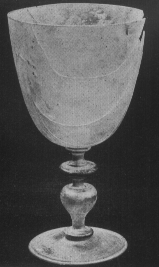
The inverted baluster is a shape that runs through English glass designs in both the seventeenth and the eigteenth centuries. The title of this group has been choosen to destinguish it from the cigar stems of group 2. The stems in this group are effectively a squat form of those cigar stems, but never the less they form a distinct grouping. There is also an affinity with the stems of group 4 which were being produced at much the same time.
This page talks about this sort of glass and includes a classification of all the variations we know about. If you know of any other variations please let us know, so we can keep the list up-to-date.

This illustration comes from John Dent's book The Quest for Nonsuchand is the most complete recorded example of this group of glasses. It was found during the excavations of the Royal Palace of Nonsuch and is estimated to date from about 1650.
As with group 2 and group 4 glasses, this type of glass would only have been made for two different types of drink - wine and beer.
In common with glasses from earlier in the period, virtually all these glasses are made from inadvertantly coloured glass due to the presence of impurities (particularly iron oxide) in the glass melting batch. Tints vary from green to brown to grey.
Ribbed moulding has been found on three of this type of stem, so it was probably not a common form of decoration. Comparison with the larger proportion of ribbed stems in group 4 suggests it was a later feature. The other type of decoration used was slightly more common. This featured the addition of two prunts (small moulded blobs of glass) one on each side of the widest part of the stem. This form of decoration was apparently confined soley to this stem group in England, although it is more common on European glasses. Most of the prunts were made for the same type of glass as the rest of the glass, with the exception of one example found in Dorchester, that has pale blue prunts. None of the prunted-glasses are from closely dated contexts. The patterns on the prunts were made by impressing stamps made from heat-resistant clay, probably the same kind as that used for glass-making pots or tobacco pipes. We know this because similar stamps from this period have been found in Germany.
Glasses of this type are among those found from the site of a glass-sellers shop that was almost certainly burnt in the great fire of London in 1666. One was also found on the site of a glass house run by Sir Robert Mansell in Broad Street, London until about 1640.
The only significant feature worth noting is that one of the fragments found has a period repair. Repairs have been noted on stems from all four early stem groups, but do not appear to be present on any of the later ones. This one (in the Museum of London) is typical, with a shaped metal cage (lead?) being used to enclose two knops and hold the broken parts of the glass together. The earliest repairs seem to date after about 1635, but there is little evidence available. See group 2 for further details
For notes on the 17th Century glass classification used Click here. In common with other early seventeenth century glasses, the basic form of this stem includes a strengthening merese at both the stem-to-bowl and the stem-to-foot junctions.